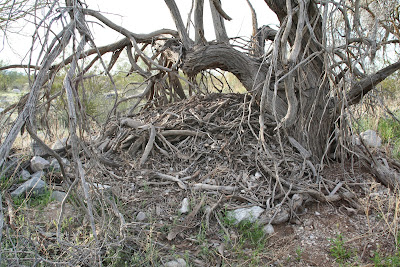 |
| A pack rat midden in the Sonoran Desert. |
You might think, “The Ice Age ended about 10,000 years ago, are there really 10,000 year old pack rat middens?” Yes, there are. In-fact some seem to be considerably older. You see, these middens are passed down from one generation to the next, some surviving very long periods of time. Middens are simply debris piles of things the pack rat collects, the first important activity of the rat as an Ice Age historian, and boy do they collect. Within 100 or so meters of their midden, the rat will collect anything they find of interest, and carry it back to be deposited on the pile. Pack rats earn their name by collecting anything, leaves, cactus pads, seeds, sticks, animal dung, rocks, even watches or buttons. Hiking through the desert southwest middens are fairly common, and are often several feet high and wide. Middens are rather gross, for besides them depositing all kinds of things on them, the rats also use them as a restroom, which results is the pack rats second important activity as an Ice Age historians. As materials are deposited on midden piles, the pack rat also urinates on the piles. This urine dries out, crystallizing around items within the midden so they are protected from decay. As a result thousands of years of materials can be protected within a midden. Though interesting, they sure aren’t pretty and they sure aren’t something normal people would want to dig into.
When I say that “normal” people would not typically want to dig into a midden I exclude scientists, because scientists are simply not normal. So of course scientists decided they should dig into these middens to see what they could find. I am sure this wasn’t even fun for the scientists but they did it anyway and what did they find? Large chunks of crystallized urine that contained preserved portions of plants that grew near the midden thousands of years ago. The scientist then carbon date each of these urine chunks and break them down to see what is inside. Then based on the age of the urine crystal and what was inside, the plants that lived near the midden could be determined for certain time periods. If enough crystals were found from enough different time periods, a continuous timeline of how plant communities changed over time can be made. This has been done many different times in many different locations in the Southwestern United States. For that reason we can get a pretty good feel for what plants lived where and when over the past 10 or more thousand years, and therefore what life might have been like during and after the Ice Age.
 |
| Central Arizona Pinyon-Juniper woodlands, possibly similar to what the Sonoran Desert looked like during the Ice Age. |
Several of these middens have been examined within the Sonoran Desert and we are able to give a fairly accurate description of how vegetation has changed since the Ice Age. Pack rat urine crystals from during the Ice Age show that the Sonoran Desert was dominated by woodland plant species typical to higher elevations further north. These woodlands were composed of singleleaf pinyon pine, juniper trees, shrub live oak, and joshua tree. This plant community indicates much cooler temperatures and more cool season precipitation. At the lower elevations where it was hotter and drier, these species were far less abundant and creosote was more common. As the Ice Age ended, the weather warmed-up and dried-out, and species more typical to what we see today in the Sonoran Desert began to increase. First, saguaro cacti and brittlebush occupied the area, followed by palo verde and ironwood. In all, it took many thousands of years of changing temperatures and rainfall patterns for the present day mixture of plants to develop here in the Sonoran Desert. This transition from woodland to desert could be compared to (but not exactly like) the transition of plants as you travel from 5000 feet in central Arizona down to around 1000 feet. Central Arizona at 5000 feet is characterized by pinyon pines, junipers, and shrub live oak. Moving down in elevation the weather warms up and dries out, similar to how the weather transitioned after the Ice Age until today. As the weather changes downslope we see an increase in Sonoran Desert plants.
 |
| Modern day Sonoran Desert. |
Today's plant communities within the Sonoran Desert are determined by the hot dry weather with both a cool and a warm season rainy periods. But the climate continues to change and therefore plant communities will continue to change. We as humans will do our best to keep track of these changes and so will the pack rat. With the variable nature of humans though it is easy to think we might somehow loose track or forget about our records overtime. Even so, the pack rat with its innate drive to pack things away will continue to do so and therefore continue to be the Southwests most consistent historical record keeper.
No comments:
Post a Comment